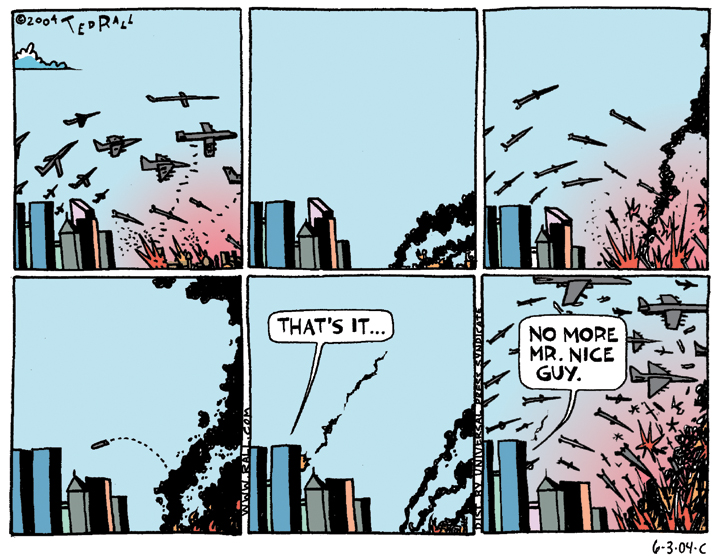
I’m a big fan of editorial cartoons, both as an artform and as a medium for political commentary. I would have to point to a number of political cartoonists that, in 1, 3, 4 or even 8 panels, have helped shape my political ideology. They say a picture is worth 1,000 words, and for editorial cartoons, that maxim is incredibly on-point. A single-panel cartoon can often convey an entire editorial’s worth of ideas. Usually, those ideas are condensed or refined, but that’s the point.

I first “discovered” political cartoons in 2000, when I would see them in the old Pittsburgh Weekly. I honestly don’t remember the cartoonists featured, though I’m fairly certain that Ted Rall was in there, and I remember eagerly awaiting the next issue largely for the cartoons. Rall was my “in” to the medium, which now seems a bit strange to me. I consider myself very far left-wing these days, but not what I would consider a radical. Rall, however, is a radical, and proud of it. His work started me on the leftward path, and while we have many issues in common, there’s a lot of disconnect between the two of us as to how to accomplish those ideas. Anyway, I digress. It wasn’t until around 2002 that I really started reading cartoons regularly. I found Daryl Cagle’s Political Cartoonist Index, which is a clearinghouse for most of the professional editorial cartoonists in America and a number abroad. I checked it daily for years before having to step back and focus on just a few. In that time I found favorites, fell out with some of those favorites, and then found new favorites.

I also found bugbears, which was a large part of my whittling down my consumption of editorial cartoons. I try not to live in an echo chamber, but that’s what we tend to do. I don’t read the likes of Michael Ramirez and Chuck Asay anymore, because they tell me nothing that interests me, but often infuriates me. Well, that’s not entirely true. Sometimes I do read them over at A Good Cartoon, which makes them manageable.
While I’m a hard-boiled leftie, I’m not a big fan of hyper-partisans and their associated news outlets like Daily Kos. This is mainly because while there are a number of people close to me ideologically there, most of them are quite willing – eager, even – to sell that ideology out to put yet another moderate-to-right wing Democrat into office, and scream at me for not doing the same. The exception I make concerning Kos, however, is Comics at Daily Kos, which was launched and is curated by another one of my favorites, Tom Tomorrow. Comics at Daily Kos is practically a clearinghouse of my favorites: Matt Bors, Jen Sorensen, and Brian McFadden, just to name a few. What’s interesting about most of the cartoonists featured on Kos is that they share my “ideology first, party very second” approach (which has earned more than one of them the ire of the group mind there).

These cartoonists have created succinct messages that have in turn lead me to discover larger points about issues that I previously was uneducated about or simply didn’t realize I should have an opinion on, which has lead me to nailing down where I stand. That has been immeasurably helpful, because my world view is very important to me. Understanding how I see the world and what I believe is allows me to not just float along, being pushed and pulled by whatever currents I happen to be in. The first election I ever voted in was 2004, because prior to that, I didn’t see the point. Cartoonists like Rall, Kirk Anderson, and David Horsey, just to name a few, helped me shape my first truly political thoughts. Heck, even the right-wing cartoonists helped by giving me a counterpoint to look at and understand that I vehemently disagreed with. Since then, I’ve voted in every primary and general since then, twice a year every year. I help out my state representative on election day. I’ve stood in the rain passing out literature for insurgent candidates who drew less than 1% of the vote.
Editorial cartooning has become a dying art, though. Newspapers are dropping cartoons, and the alt-weeklies, long the cash-cow for modern cartoonists, have begun slashing costs wherever they can, starting with their cartoon syndication. Cartoonists are turning more and more to new forms of revenue to continue doing what they do, from merchandising their websites to running Kickstarter campaigns to put out book collections. So when you see a Kickstarter for a cartoonist that you like, kick in a few dollars. If your local newspaper runs editorial cartoons, let them that you appreciate them running editorial cartoons and ask them to get a few more. If they don’t, tell them that they should get one. If you come across an editorial cartoon that you like and want to post it to social media, find out who drew it and link to their website. But most of all, keep reading them!
*Disclosure (which makes me appear cooler than I actually am): I coded www.mattbors.com and www.jensorensen.com.
